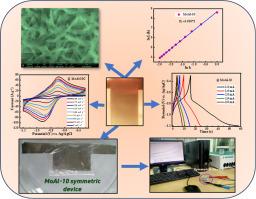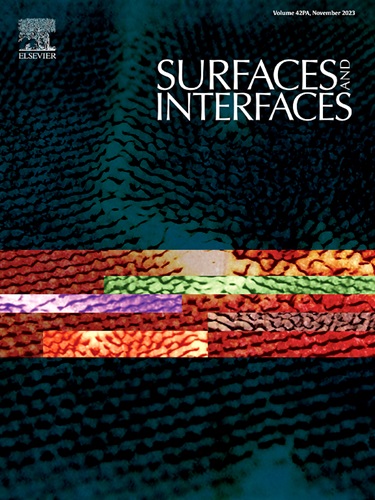Fractal supported electrochemical analysis of MoO3 decorated AlOOH binary composite for supercapacitor application
IF 5.7
2区 材料科学
Q2 CHEMISTRY, PHYSICAL
引用次数: 0
Abstract
The AlOOH/MoO3 binary composite electrodes are synthesized by layer-by-layer method to enhance the supercapacitive property of AlOOH by taking advantage of multiple oxidation states of molybdenum. The X-ray diffraction characterization reveals the polycrystalline nature of nanocomposite. The elements and their chemical states are analysed using X-ray photoelectron spectroscopy. The binary composite exhibits interconnected network-like morphology resembling a fractal nature. The three-electrode measurement in 1 M KOH electrolyte shows the highest specific capacity (Cs) of 1638.15 C g-1@ 5 mV s-1 for binary composite, which is greater than the capacity of individual components. Also, we get Cs of 1124.41 C g-1 for 10 cycle MoO3 while its theoretical capacity is 1005 C g-1. The excellent electrochemical performance is a consequence of multiple redox active sites present in the nanocomposite, lower resistance, porous interconnected network-like structure, and shorter relaxation time. The synergy of AlOOH with MoO3 enhances its charge storage capacity. The obtained electrochemical results are also theoretically supported by fractal analysis. Among all the electrodes, the 10 cycle AlOOH/MoO3 nanocomposite displays high value of fractal dimension, which is advantageous for supercapacitor application. Furthermore, we have fabricated a symmetric supercapacitor device to understand the practicality of current work. The fabricated device displays Cs of 68.41 F g-1 within 1.6 V potential window with ∼71 % capacity retention and 100 % coulombic efficiency after 7000 charge-discharge cycles. The highest energy density of 24.32 Wh kg-1 is achieved for the power density of 3907 W kg-1.

用于超级电容器的 MoO3 装饰 AlOOH 双元复合材料的分形支持电化学分析
通过逐层法合成了 AlOOH/MoO3 二元复合电极,利用钼的多种氧化态增强了 AlOOH 的超级电容特性。X 射线衍射表征揭示了纳米复合材料的多晶性质。利用 X 射线光电子能谱对元素及其化学状态进行了分析。二元复合材料呈现出类似分形的互连网状形态。在 1 M KOH 电解液中进行的三电极测量显示,二元复合材料的最高比容量(Cs)为 1638.15 C g-1@ 5 mV s-1,高于单个成分的容量。此外,10 周期 MoO3 的比容量为 1124.41 C g-1,而其理论容量为 1005 C g-1。优异的电化学性能得益于纳米复合材料中存在的多个氧化还原活性位点、较低的电阻、多孔互连的网状结构以及较短的弛豫时间。AlOOH 与 MoO3 的协同作用增强了其电荷存储能力。分形分析也从理论上支持了所获得的电化学结果。在所有电极中,10 次循环的 AlOOH/MoO3 纳米复合材料显示出较高的分形维值,这对超级电容器的应用非常有利。此外,我们还制作了一个对称超级电容器装置,以了解当前工作的实用性。在 1.6 V 的电位窗口内,所制造的装置显示出 68.41 F g-1 的 Cs,在 7000 次充放电循环后,容量保持率为 71%,库仑效率为 100%。功率密度为 3907 W kg-1 时,能量密度最高,达到 24.32 Wh kg-1。
本文章由计算机程序翻译,如有差异,请以英文原文为准。
求助全文
约1分钟内获得全文
求助全文
来源期刊

Surfaces and Interfaces
Chemistry-General Chemistry
CiteScore
8.50
自引率
6.50%
发文量
753
审稿时长
35 days
期刊介绍:
The aim of the journal is to provide a respectful outlet for ''sound science'' papers in all research areas on surfaces and interfaces. We define sound science papers as papers that describe new and well-executed research, but that do not necessarily provide brand new insights or are merely a description of research results.
Surfaces and Interfaces publishes research papers in all fields of surface science which may not always find the right home on first submission to our Elsevier sister journals (Applied Surface, Surface and Coatings Technology, Thin Solid Films)
 求助内容:
求助内容: 应助结果提醒方式:
应助结果提醒方式:


